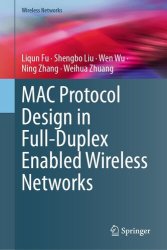MAC Protocol Design in Full-Duplex Enabled Wireless Networks
- Добавил: literator
- Дата: 21-05-2024, 10:52
- Комментариев: 0
 Название: MAC Protocol Design in Full-Duplex Enabled Wireless Networks
Название: MAC Protocol Design in Full-Duplex Enabled Wireless NetworksАвтор: Liqun Fu, Shengbo Liu, Wen Wu, Ning Zhang
Издательство: Springer
Серия: Wireless Networks
Год: 2024
Страниц: 158
Язык: английский
Формат: pdf (true), epub
Размер: 24.1 MB
This book thoroughly examines the design of full-duplex medium access control (MAC) protocols in wireless networks. It is organized into three main sections: (a) Fundamentals and preliminaries of full-duplex communications, (b) A comprehensive review of the existing full-duplex MAC protocols, and Designs of full-duplex MAC protocols in three typical wireless networks, i.e., wireless local access networks (WLANs), multi-hop networks and millimeter-wave networks. Also, the authors extensively address key challenges in these three wireless full-duplex networks, such as the hidden-node problem, accumulative interference, and deafness and blockage problems. Solutions to these challenges are meticulously devised to enhance the overall network performance.
Full-duplex (FD) communication has emerged as one of the most promising technologies in future wireless networks, enabling simultaneous transmission and reception in the same frequency band. Compared with the current half-duplex (HD) system, FD communication can theoretically double the link capacity and spectrum efficiency, hence attracting extensive attention from academia and industry. To fully exploit the benefits of FD communication in wireless networks, medium access control (MAC) protocols should be appropriately designed for FD-enabled wireless networks. To adapt to different scenarios, FD should support different transmission modes, such as FD bidirectional transmission, simultaneous uplink and downlink transmission, and multi-hop FD relaying transmission (also known as cut-through transmission). However, these FD transmission modes cause complex interference patterns, which pose significant challenges in FD MAC protocol design: (1) HN problem in FD-enabled wireless local area networks (WLANs), which significantly degrades network performance. Existing HN solutions that are designed for HD networks fail to deal with HN problem in FD networks, because there are at least two transmitters in an FD transmission link, resulting in a complex interference footprint; (2) Huge protocol signaling overhead and poor spatial reuse in wireless multi-hop networks with cut-through capability. In contrast to single-hop HD relaying transmission, cut-through transmission can simultaneously span multiple hops, resulting in a substantial increase in protocol signaling overhead due to control frame transmissions and a considerably extended carrier-sensing range. Furthermore, the presence of multiple cut-through modes introduces great complexity in achieving maximum end-to-end throughput by enhancing spatial reuse in wireless multi-hop networks; (3) Deafness problem and asymmetric transmission issue in millimeter-wave (mmWave) FD networks. The deafness problem caused by directional FD transmission, i.e., a node cannot respond to a transmitter’s request as it is beamformed towards another direction, can result in severe collisions in high user density scenarios. Moreover, the asymmetric transmission issue caused by severe residual self-interference (SI) can lead to significant throughput degradation.
In this monograph, we design novel MAC protocols for FD-enabled wireless networks. Specifically, we focus on addressing the above challenges respectively by (1) designing a carrier-sensing based HN-free FD MAC protocol for FD WLANs, (2) designing a novel cut-through based MAC protocol with efficient spatial reuse for multi-hop networks, and (3) designing a busy-tone based directional MAC protocol for mmWave FD networks. In Chap. 1, we introduce wireless FD communication and its research challenges in FD-enabled wireless networks. In Chap. 2, we review the self-interference cancellation techniques, the state-of-the-art FD MAC protocols, and performance analysis in FD wireless networks. In Chap. 3, we comprehensively investigate the HN problem in the FD WLANs and present a carrier-sensing based HN-free MAC protocol design. In Chap. 4, to optimize the end-to-end throughput in a wireless multi-hop network, we design a low-overhead MAC protocol to support cut-through transmissions and propose a transmit-delay mechanism to improve spatial reuse and link scheduling. Furthermore, we design an algorithm to adaptively select the transmission parameters, including the cut-through mode, the spatial reuse factor, and the channel rate, to improve the end-to-end throughput. In Chap. 5, for FD mmWave networks, we design a novel busy-tone based FD MAC protocol supporting typical directional FD transmission modes. Moreover, we also propose a power control algorithm to handle the asymmetric transmission issue. At last, we conclude this monograph and discuss future research directions in Chap. 6.
We hope this monograph can provide insight into understanding the fundamental performance of FD wireless networks in different network scenarios, including WLANs, multi-hop networks, and mmWave networks. The systematic principle in this monograph also offers valuable guidance on the establishment and optimization of future FD wireless networks.
Скачать MAC Protocol Design in Full-Duplex Enabled Wireless Networks
Внимание
Уважаемый посетитель, Вы зашли на сайт как незарегистрированный пользователь.
Мы рекомендуем Вам зарегистрироваться либо войти на сайт под своим именем.
Уважаемый посетитель, Вы зашли на сайт как незарегистрированный пользователь.
Мы рекомендуем Вам зарегистрироваться либо войти на сайт под своим именем.
Информация
Посетители, находящиеся в группе Гости, не могут оставлять комментарии к данной публикации.
Посетители, находящиеся в группе Гости, не могут оставлять комментарии к данной публикации.
